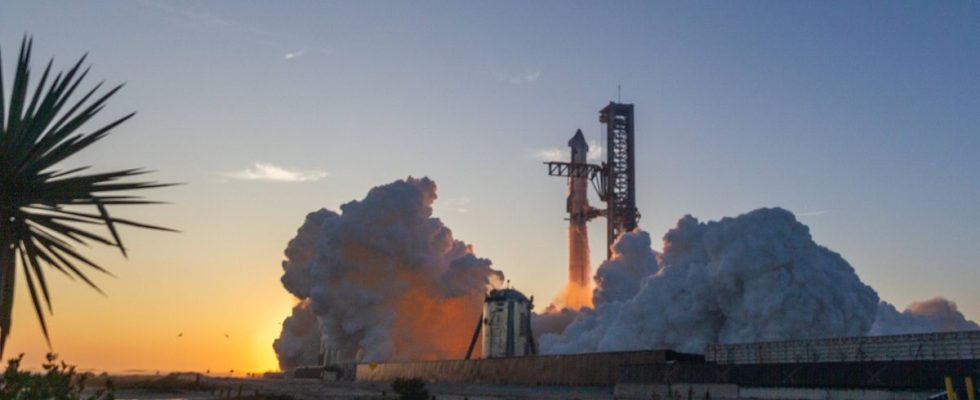It all ended in an explosion. On Saturday, SpaceX tested its giant Starship rocket for the second time, eagerly awaited by NASA to move on to a new generation of missions in space. But six months after a first flight which had already ended with a big “boom”, none of the two stages of the rocket could be recovered, contrary to what the specifications provide. However, the two parts of the rocket separated correctly, and the Starship module reached space.
So, what exactly happened during that eight-minute flight? Can we really call it a failure? Does this call into question the Artemis III lunar mission, planned for 2025? 20 minutes takes stock with Chloé Carrière, an aerospace engineer who graduated from EPFL and is involved in popularizing science.
What happened during this second test flight?
Almost six months to the day after the first flight of Starship, which disintegrated, a new version of “the largest rocket ever built” was ready on Saturday in Boca Chica, south Texas. “It’s a monstrous rocket, a technological challenge” to get off the ground, explains Chloé Carrière. And everything seemed to be going well. The 33 engines of the propulsion stage, called SuperHeavy, remained on, where “during the first test, some engines had shut down”. At 2:03 p.m., the 7,600 tons of thrust from the engines made the 121 meter high machine take off.
A few minutes later, SuperHeavy and the Starship module detached successfully at approximately 75 kilometers altitude. Then things got worse. “The booster part did not manage to come back to land, it is not yet very clear whether it was planned or not,” begins Chloé Carrière. Known for its reusable Falcon 9 launchers, SpaceX will undoubtedly be keen to reuse the enormous and expensive SuperHeavy, which exploded during its descent. Finally, “after 8 minutes, we lost contact with Starship”, on a scheduled 90-minute flight. The module, briefly passed into space, “had to come back down towards Hawaii”. He finally exploded too.
A double explosion for a second launch, can we speak of a failure for SpaceX?
Obviously, for the company of billionaire Elon Musk, completing this test with charred debris does not send a signal of confidence. However, this second flight is far from being negative. “To borrow the English term successful failure, let’s say that we are on a successful failure”, image Chloé Carrière. “We did not achieve the final objective of landing the first stage and following the suborbital trajectory until re-entry into the atmosphere, but there has been a great deal of progress and many other objectives achieved.”
In addition to the good ignition of the engines, “the launch platform remained intact” a priori, although it had suffered major damage six months ago. “Two other major objectives were achieved”, underlines the aerospace engineer: “the critical moment when the maximum stress on the structure” was reached and crossed, and the separation of the two stages went well. Far from the multiple anomalies which had led the first rocket to an erratic trajectory a few kilometers above sea level. Moreover, speaking of heights, “the Starship module reached space by crossing the Karman line,” explains Cholé Carrière.
The Starship rocket is expected for the Artemis III lunar mission, scheduled for 2025. Could this second explosion delay the project?
So many positive points which have notably delighted Thomas Pesquet, the French astronaut, who soon hopes to take his place aboard the rocket for a lunar mission. Because with Starship, SpaceX sees far. The company “wants to transport up to 100 people to Mars in the long term,” recalls Chloé Carrière. By then, the rocket will already have work on putting satellites into orbit, but also on the lunar missions that NASA wants to relaunch. The first of these, Artemis III, is planned for 2025. Two years from the end, seeing the module explode may raise doubts. But “to say that it risks delaying the mission is to simplify things,” reassures the engineer based in Switzerland.
“Many other key technologies also remain to be developed and are behind schedule,” she points out. Indeed, in addition to NASA and SpaceX, Japan and even the ESA are participating in the project, and not everyone is on time, as is often the case with this type of project. “Starship will certainly not be the last ready technology,” says Chloé Carrière, who welcomes SpaceX’s “experimentation process,” making it possible to rectify the trajectory of the project as it goes along rather than directly assigning “an enormous budget” to it. and a deadline to meet. “We must not stop at this explosion, in failure we learn”, she emphasizes, wanting to retain a test “perhaps not entirely nominal compared to what was planned but still impressive” given its progress.

